Lost to fire, Ford’s Rotunda drew more visitors than the Statue of Liberty
Ford called it the “Show Place of the Automotive Industry,” and even a title that brazen may have understated the widespread appeal of the Rotunda. By the early 1960s, Ford’s futuristic Rotunda was not only the most popular automotive-related tourist destination in the United States, it was the fifth-most visited attraction overall, seen by more people than the Statue of Liberty, the Washington Monument, and Yellowstone National Park.
Never heard of the Ford Rotunda? You’re forgiven. It’s been six decades since the building was lost forever on November 9, 1962.
On that pleasant Michigan afternoon, workers were applied waterproofing sealant to the roof when a heater ignited the fumes. The beloved structure was consumed in a flash of flames. Less than an hour later, it was destroyed. While the Ford Rotunda is now relegated to photos and faded memories, those who remember it do so fondly, not just for its endless automotive displays and history lessons, but for its massive Christmas makeover each year.
“Over the years, the Rotunda acquired a special personality all its own,” Detroit Free Press columnist Mark Beltaire wrote in 1962. “It was known and recognized by people who had never been inside. They were aware of the Rotunda, especially at night, even while driving many miles away.”
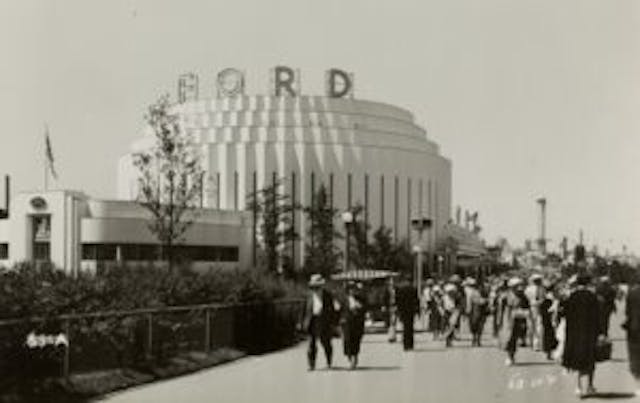
Built by legendary Detroit architect Albert Kahn as the centerpiece of Ford’s exhibit in the 1933–34 Century of Progress International Exposition in Chicago, the Rotunda stood 10 stories tall and resembled gears stacked atop one another. Kahn had already designed a number of iconic Motor City buildings, including the Packard plant and Ford’s River Rouge plant, but this one was unlike any he had ever created. World’s Fair attendees flocked to it.
Henry Ford so loved the Rotunda that at the end of the fair, he wanted to add it to his collection of historic buildings at Greenfield Village, just a short drive from the Rouge, and use it to display historical advancements in industrial engineering. However, Edsel Ford convinced his father that it would be better used as a visitor center and starting point for the company’s popular Rouge plant tours. So, the huge structure was disassembled and shipped to Dearborn, where it was reassembled in 18 months—with slight design changes made by Kahn—on a 13.5-acre site across from the Ford Administration Building on Schaefer Road.
The building’s 1000-ton steel frame was covered in 114,000 square feet of Indiana limestone, and its expansive interior featured murals showing the River Rouge assembly line. Ford’s newest cars were on display. Outside, the Rotunda also featured the original “Roads of the World” exhibition from the World’s Fair. (Later, two wings were added, one for the Ford Motor Company Archives and the other for a theater. In 1952, an 18,000-pound dome was added over the courtyard; it was the first real-world application of inventor R. Buckminster Fuller’s lightweight geodesic dome.)
On May 14, 1936, the relocated Rotunda opened its doors to the public. It was an immediate hit, just as it had been at the World’s Fair. Ford says the Rotunda welcomed more than 61,000 visitors the first week and that during the 26 years that followed—including four during World War II in which the building was shuttered—more than 13 million people visited. (Some sources put that number between 16 and 18 million.)
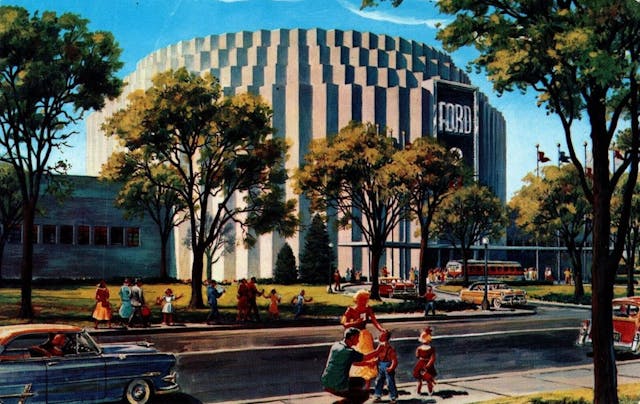
Beginning in late November 1953, following an extensive restoration timed to celebrate the company’s 50th anniversary, Ford hosted its first Christmas Fantasy extravaganza. Growing in size and complexity each year, the annual transformation became the Rotunda’s biggest drawing card, and it’s no wonder.
Its features included a 35-foot-tall tree with thousands of lights, Santa’s workshop with a crew of animatronic elves, a life-size Nativity that the National Council of Churches called the country’s “largest and finest,” and a wall display of more than 2000 dolls that were dressed by members of the Ford Girls’ Club and later given to underprivileged children. The overall theme changed each year—featuring everything from storybook characters to circus animals—but the pinnacle of every Christmas Fantasy was the opportunity to visit Santa Claus himself … after standing in a long line of children and parents, of course.
On the day of the fire, workers were busy erecting the indoor displays in time for the festivities, while workers outside were waterproofing the dome panels in anticipation of winter weather.
Author David Maraniss described the scene in Once in a Great City, his 2015 book about Detroit in the 1960s:
The quintessentially American harmonic convergence of religiosity and commercialism was expected to attract more than three-quarter of a million visitors before the season was out, and for a generation of children it would provide a lifetime memory—walking past the live reindeer Donner and Blitzen, up the long incline toward a merry band of hardworking elves, and finally reaching Santa Claus and his commodious lamp.
An elementary school class had just left the Rotunda when, about 1 p.m., a worker reported flames on the roof. A security guard quickly called the fire department and evacuated the building, but by the time firefighters arrived, the roof was fully ablaze. Soon the steel frame began to buckle, and at 1:56 p.m., firefighters were ordered away from the building as the walls began to crumble.

In Once in a Great City, a witness said the building’s collapse looked “as though you had stacked dominos and pushed them over.” The roof crashed into the Christmas displays below, and flames shot 50 feet into the sky before firefighters could control them.
The Ford Rotunda, which earlier in the day was being prepared for a highly anticipated Christmas celebration, now sat in smoldering ruins. The spirits of thousands of past and future visitors sank.
Ford considered rebuilding the Rotunda, but the price tag was an astounding $15 million, the equivalent of more than $147M today. What remained of the building was razed, along with the theatre, which had also been destroyed. (On the bright side, the Ford Motor Company Archives survived.)
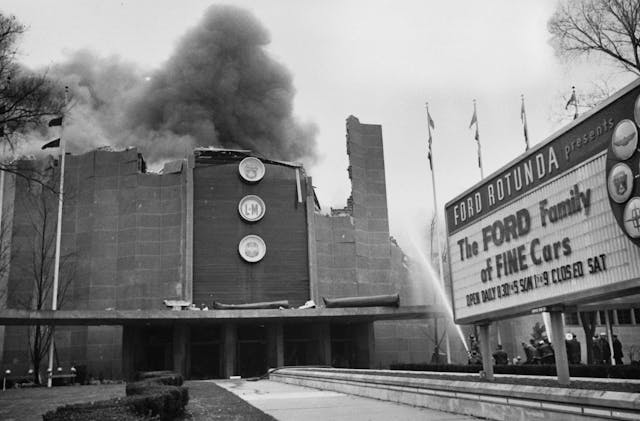
The site sat vacant for nearly 40 years until the Henry Ford College Michigan Technical Education Center (M-TEC) opened there in 2000.
The Rotunda, a uniquely designed building that was once the fifth-most visited tourist attraction in the U.S.—behind only Niagara Falls, Smokey Mountain National Park, the Smithsonian, and the Lincoln Memorial—is now just a footnote in automotive history. But to those who saw it in person, especially at Christmas or illuminated a night, it was much more than that.
“Tears for a building?” Beltaire asked in his Free Press column, written after the fire. “Of course, and many [tears] when such as the Ford Rotunda dies.”
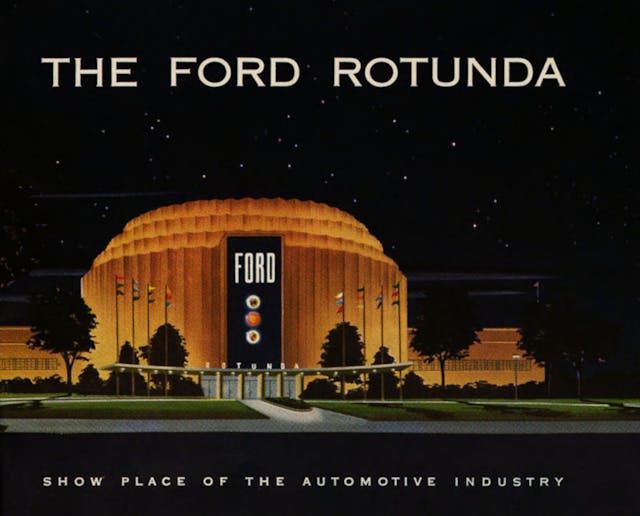

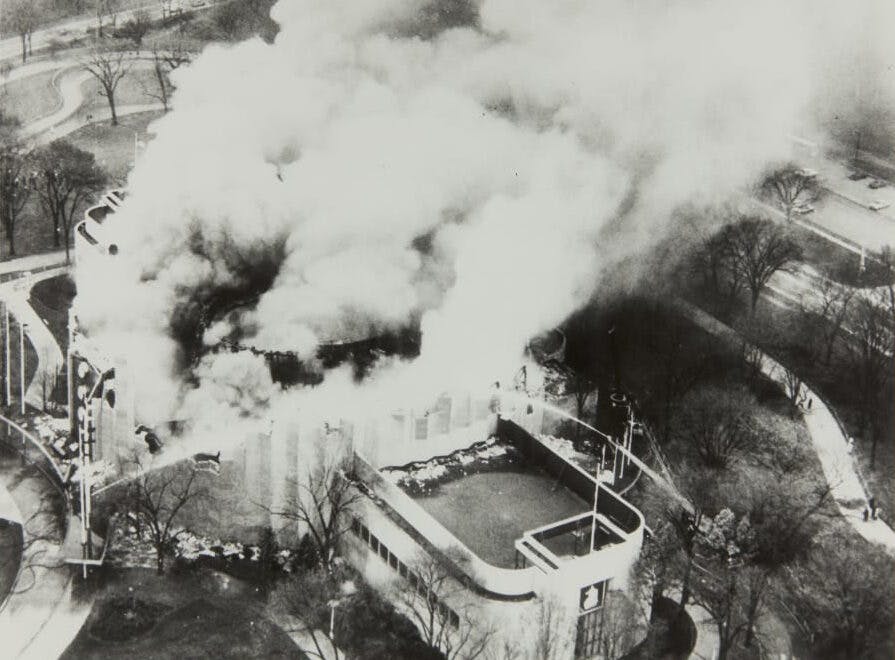
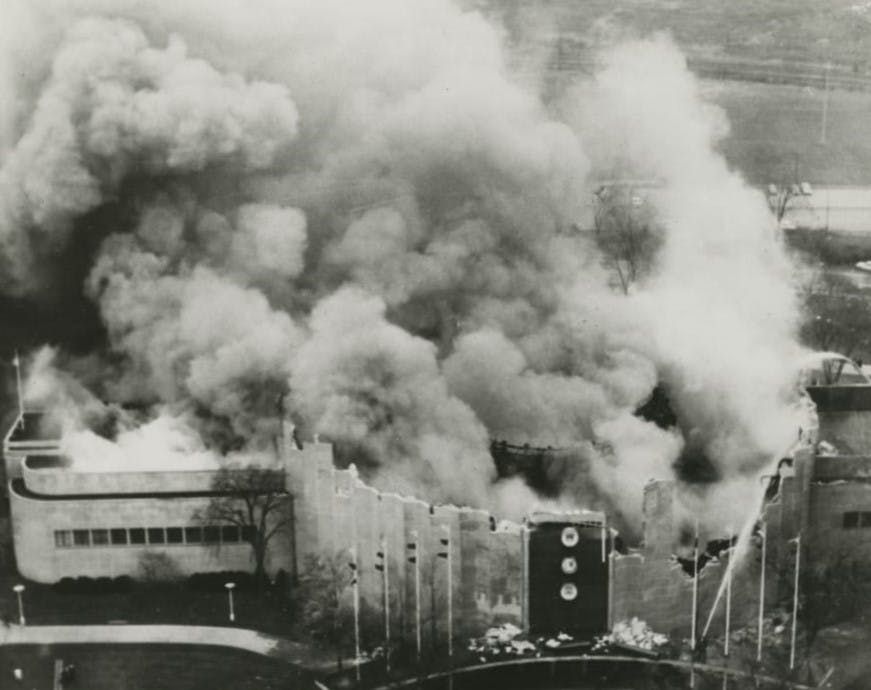
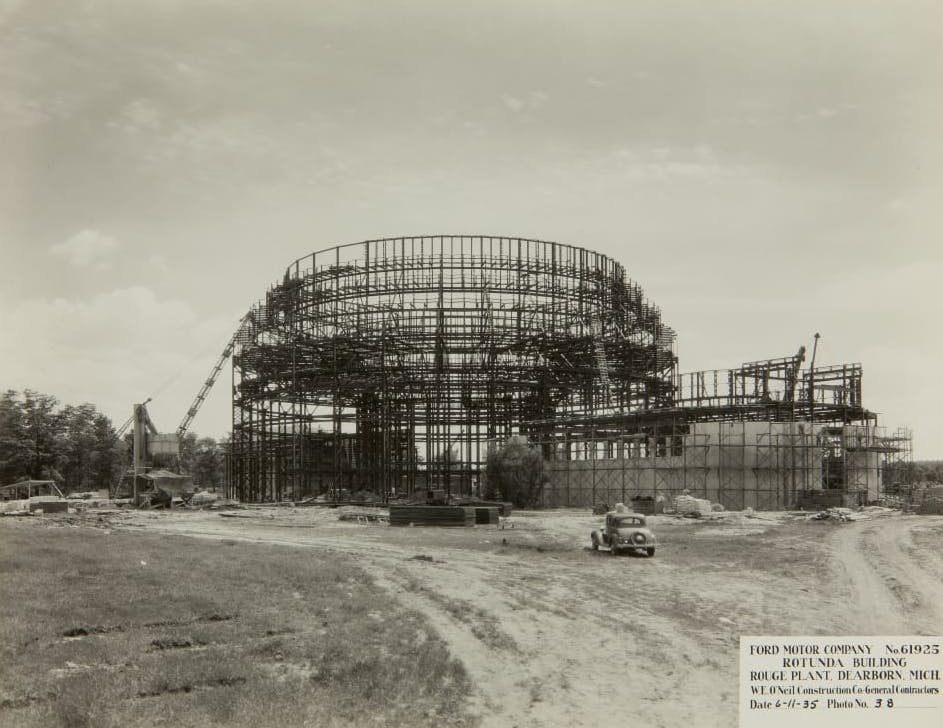
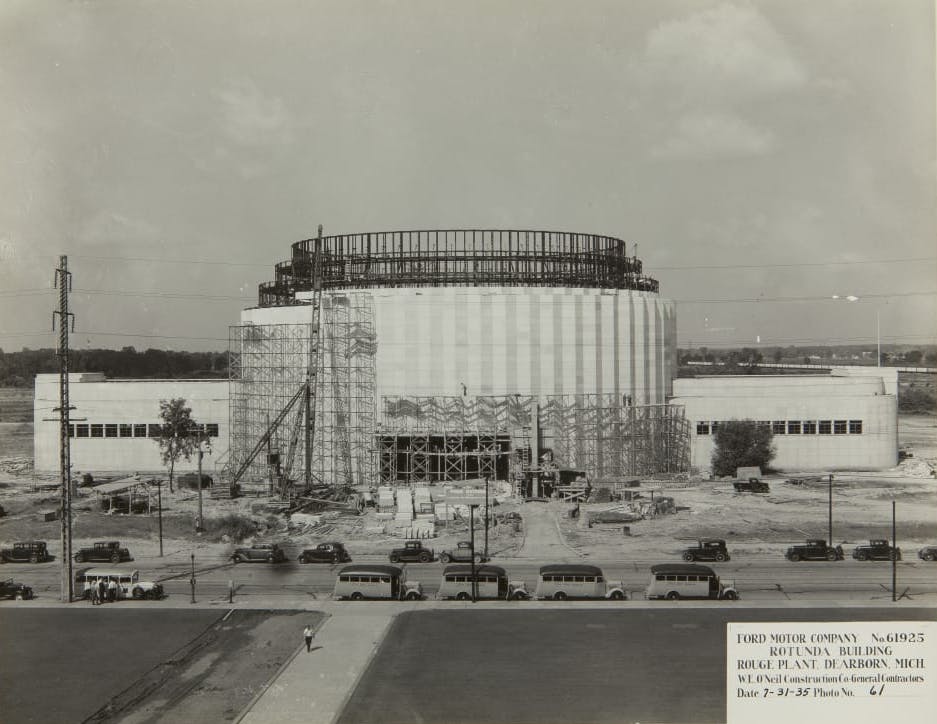
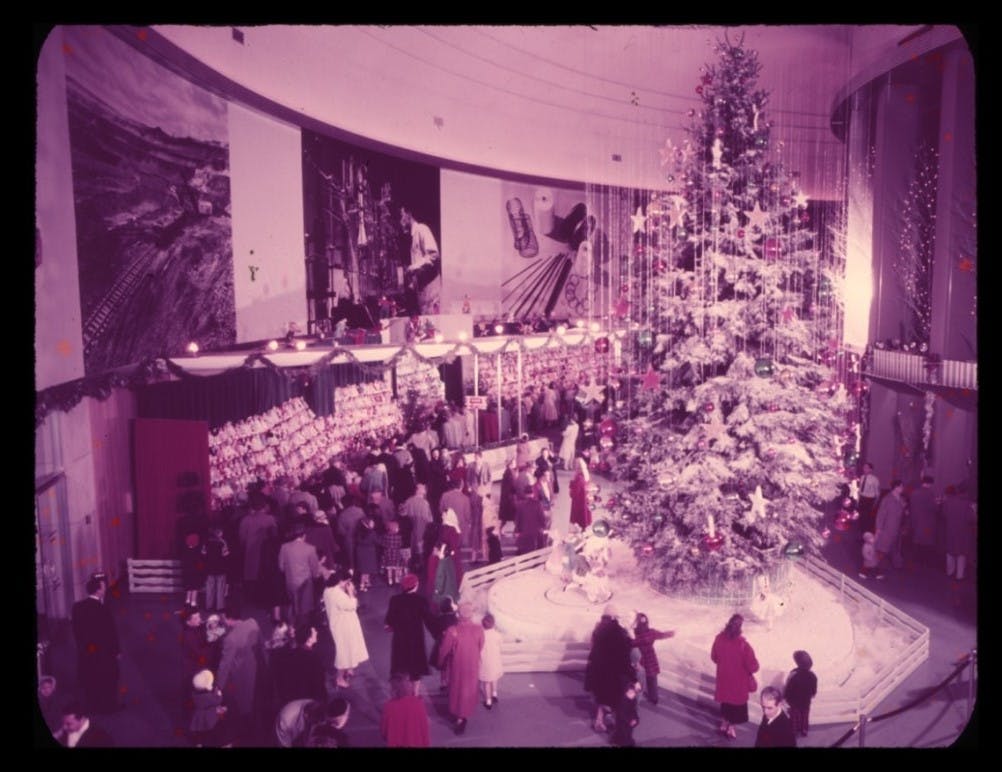

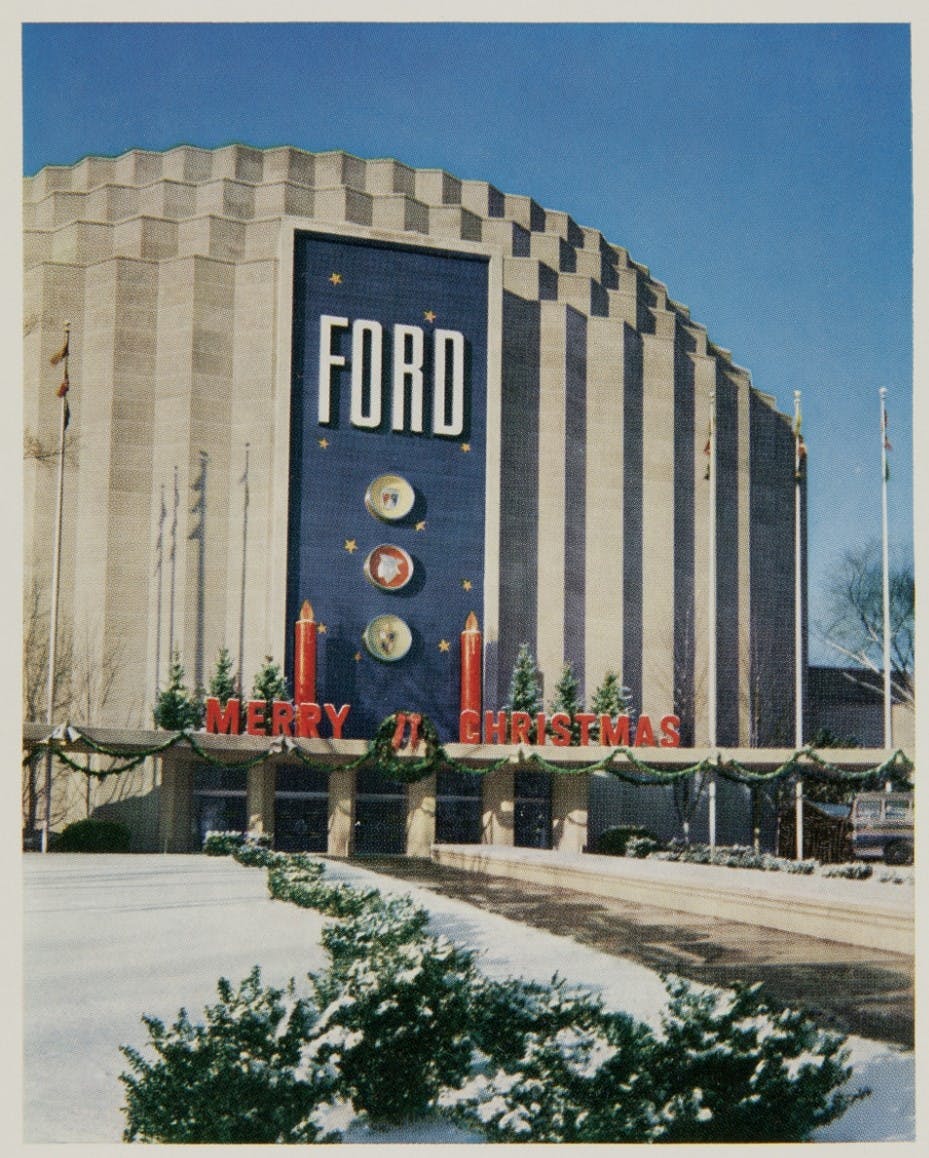
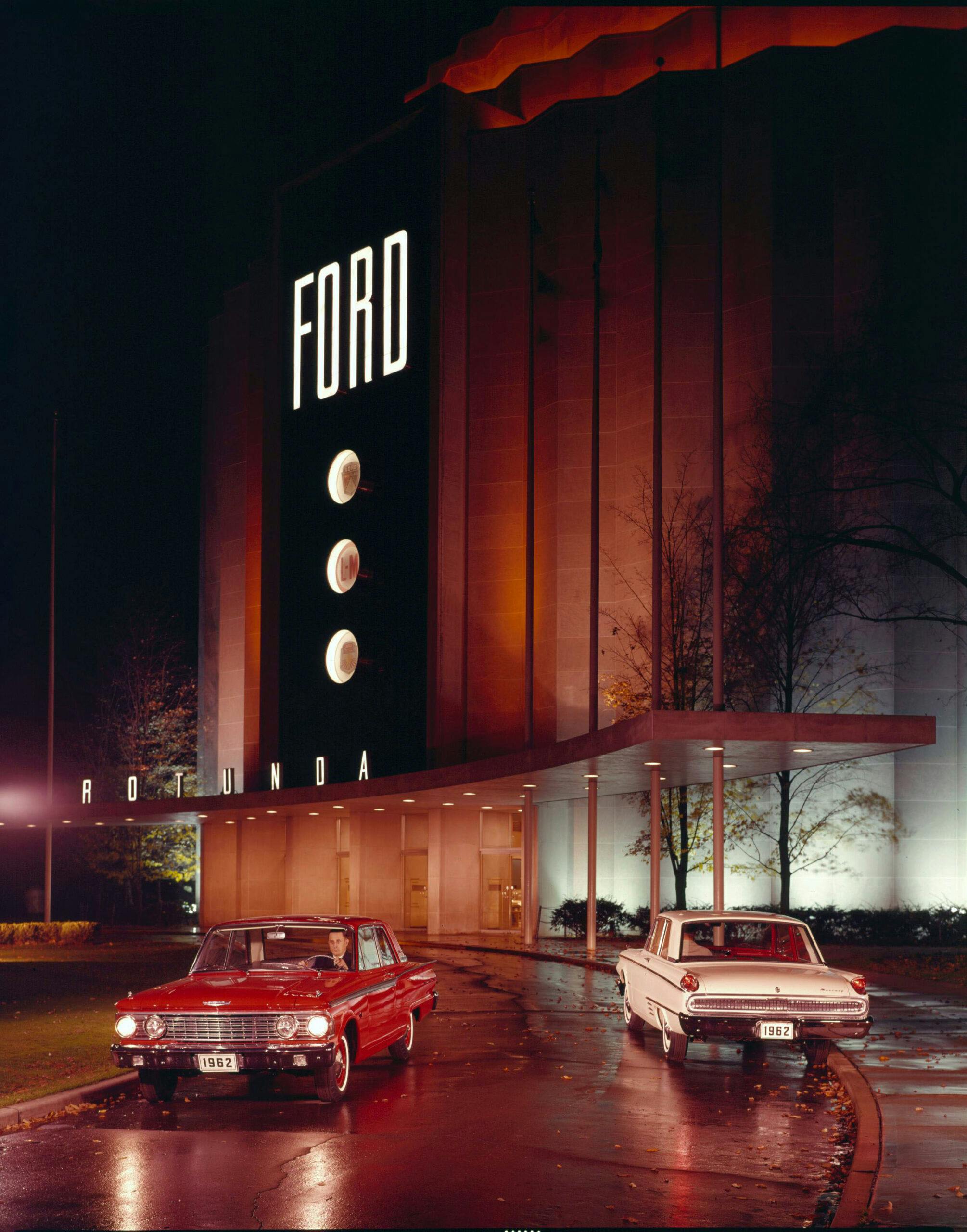
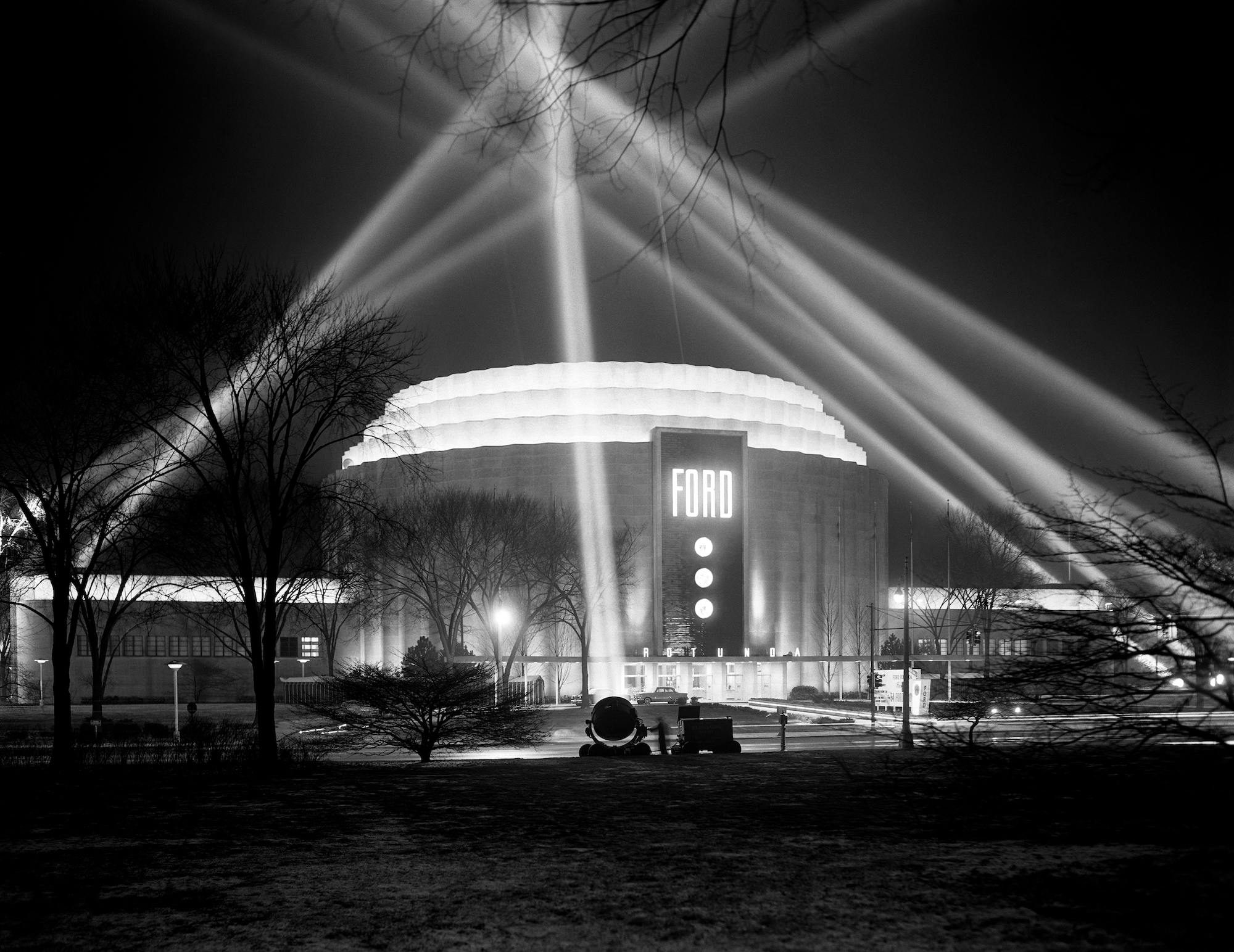
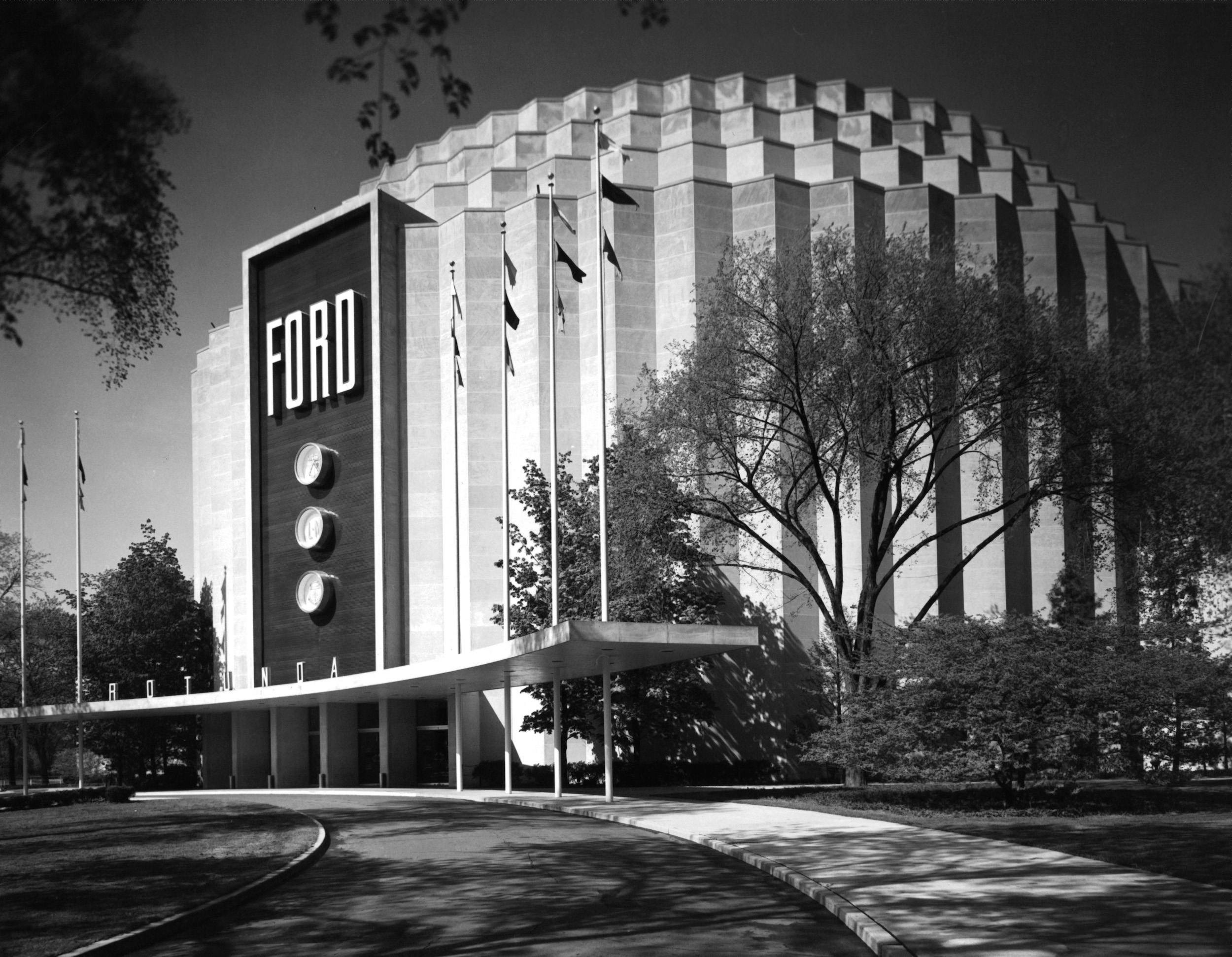
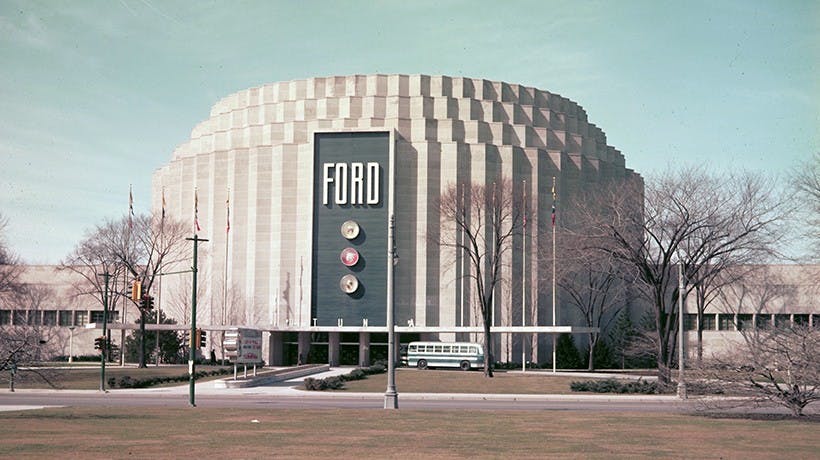
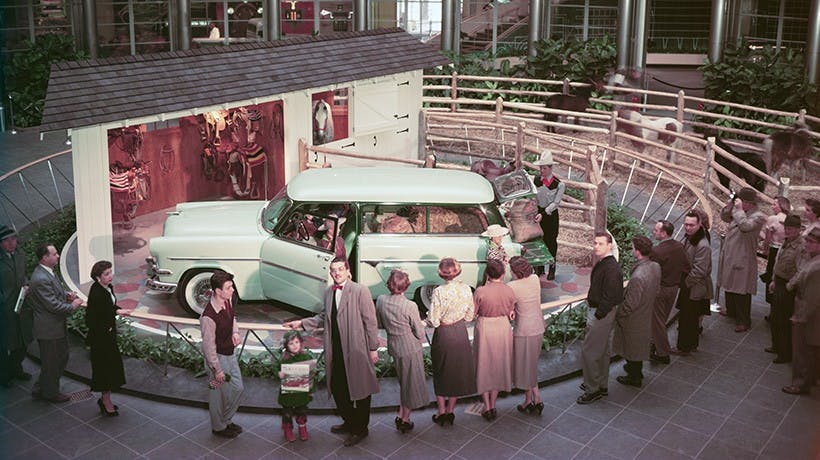
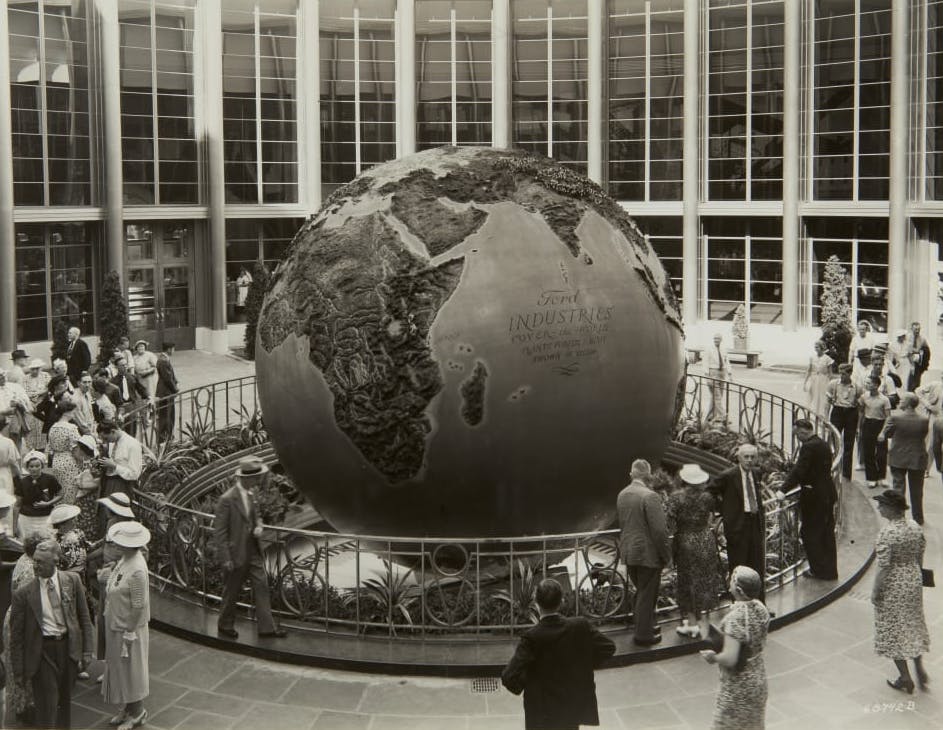
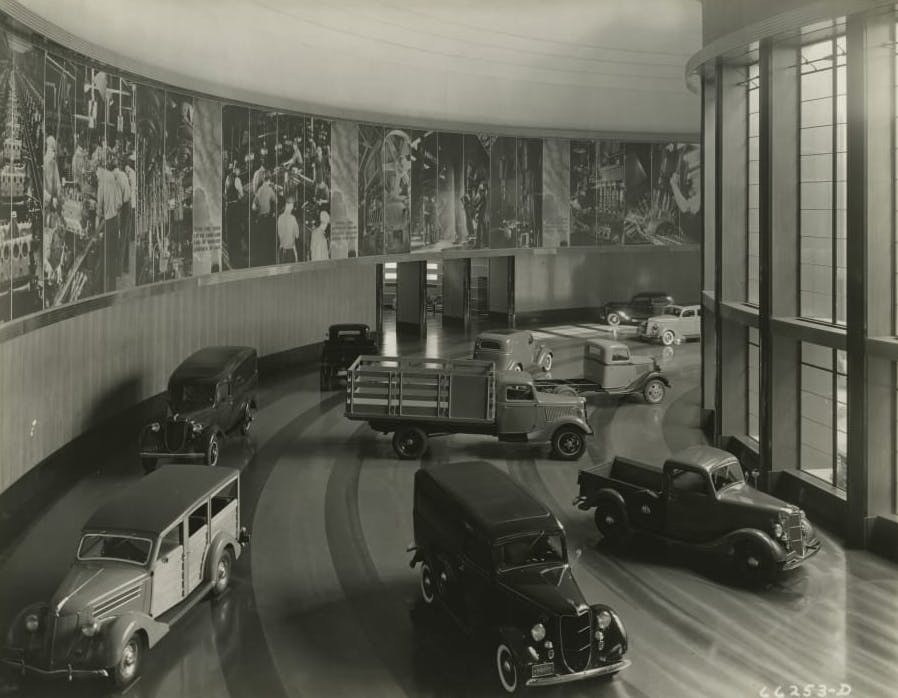
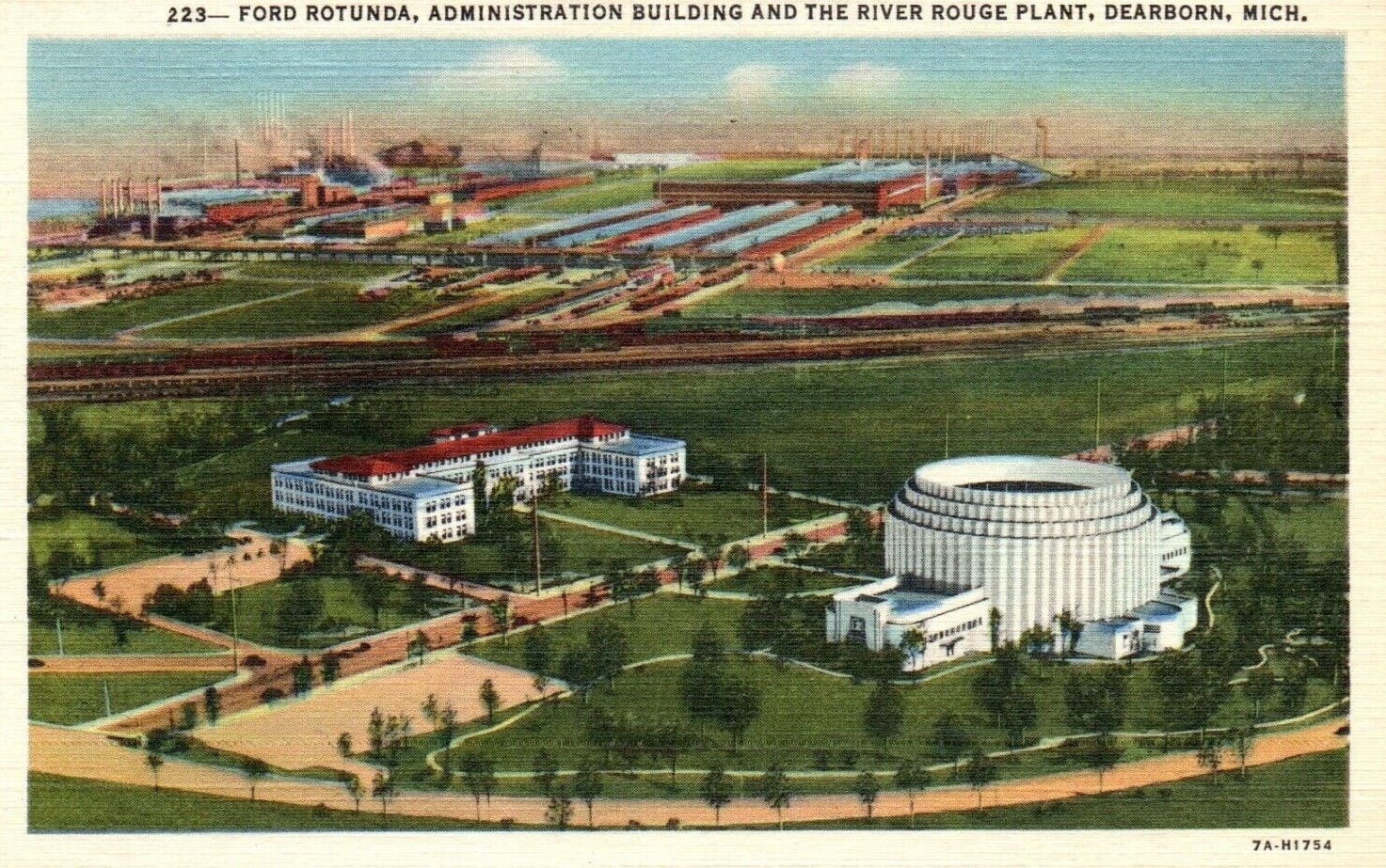

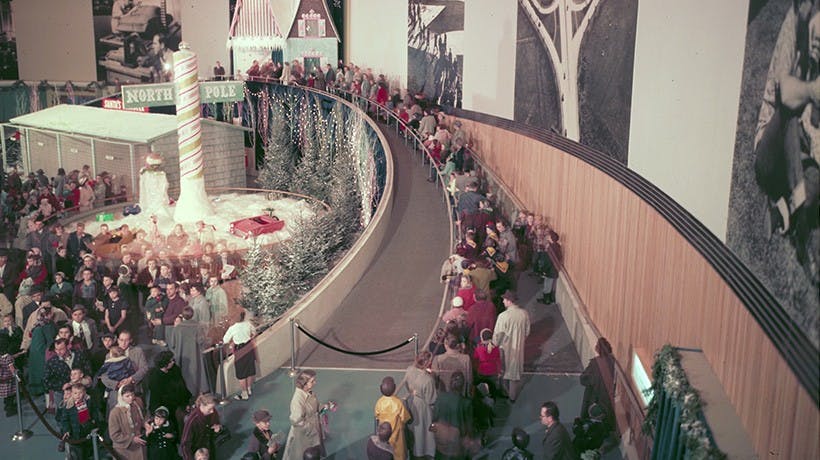


I recall all the part boxes used to say Rotunda.
Wags claimed to see the motif in Ford hubcap and taillight designs.
My dad was a devoted Ford man then, and took it pretty hard (well, no crying, but it was talked about.)
Have things gone downhill for Ford, and Detroit, ever since? It may have been an ill omen.
Yes, indeed. My mom worked for a small town Ford dealership from the late ’50s until I came along in ’69. She still has some Rotunda cans at home with dusting rags in them from that era.
I lived about two miles from the Rotunda. My brother worked in the office of D.T, & I Railroad in the Schaefer Building. He called our house and I answered the phone. He said, “Look out the kitchen window.” I did, I saw a big column of black smoke. I asked what is burning? He said, “The Rotunda.” I said, “How? “It is all concrete.” It made me sick to hear that.
Me and my friends used to ride our bikes up there when we were kids. Park them in a bike rack. Then ride in a new Lincoln around the Roads of the World around the Rotunda.
In 1969 I hired on the Dearborn Fire Department. I worked with the older guys who were at the Rotunda fire. They said it was weird while fighting the fire inside the new Fords were still going around on the display turntables. When the walls started cracking they dropped the hoses and ran for their lives as the walls came down. I heard many stories from them. Can’t remember them now.
So sad…
Perhaps it could be rebuilt.
It SHOULD be rebuilt. It makes a lot more sense than when they built the RenCen or now restoration of the old Detroit train station to be a office building and hotel.
Other than holiday decorations, what contents were lost? I assume some very interesting and important automobiles and memorabilia were lost.
Is there a youtube or video of the building and displays?
Hmmm. 1962 – not many people were walking around with video cameras in their dial up telephones. So – probably not!!!
There should be a lot of 8mm or Super 8mm film on those small 5 minute reels.
Yes there’s a utube of “Fords Christmas fantasy” that was held in the Rotunda. I went as a kid and it was really something to see. Can remember the fire as if it was yesterday, it really affected the area
Here’s the link
https://youtu.be/XAvaNocyecE
Wow, thank you for sharing I never knew about the Rotunda’s history till now. For all I knew Rotunda was the name of Ford’s parts division. I was born that same year it was destroyed, so sad and such a waste. Long time Ford fan and vintage Mustang owner. I will share this link with my fellow club members.
This utube video gives more insight to how truly spectacular the “Ford Rotunda” was and the millions of families to this day that have memories.
https://youtu.be/fKWfBtk3MDI
Do you remember a large snow man slide for kids. I think I was there when I was 3 years old.
Would someone please explain to me, if it first opened in May 1936, how could they have been celebrating the 50th anniversary in 1953? What am I missing here….?
“Beginning in late November 1953, following an extensive restoration timed to celebrate the Rotunda’s 50th anniversary, Ford hosted its first Christmas Fantasy extravaganza
Ford Motor’s 50th anniversary
It would have been Ford’s 50th anniversary.
I think it should have said: Ford Motor Company’s 50th Anniversary.
I grew up in Dearborn, and as a kid, I always looked forward to going to the Ford Rotunda.
It was an amazing place at Christmastime – with a huge Christmas tree inside, Santa Claus at the top of a long ramp, a myriad of Christmas exhibits, and the Nativity Scene in the central section, with local choirs singing Christmas carols in the evenings. During the rest of the year, there were all sorts of interesting Ford exhibits, plus their latest cars, and you could go for a ride in a new Ford car on a test rack that featured “roads of the world” (e.g. paved, cobblestone, brick, etc.). The Rotunda is also where you got on the bus to go tour the Rouge Plant.
A couple of days after the November 1962 fire – my dad drove us right up near the Rotunda – the circular / main section had jagged cement / stone walls – only about one story high remaining – and the steel structural girders within were melted and twisted like blackened pretzels in a heap. Even as a seven year old at the time – I already had many great memories of the Rotunda – this was a great loss for the entire area…
Thanks for sharing your personal memories. Such a sad story. Wish I’d seen it.
Hey Jeff: interesting side note At that time largest studebaker dealer in Portsmouth NH was B Franklin Peek. Thought might interest you?
I grew up in Dearborn and was in one of the school choirs that performed at the Rotunda. We did “The Little Drummer Boy and one of my classmates accompanied us on a drum. It was such a magical place and a truly special memory in my life. We performed the year before the fire and it was just devastating that it was gone.
…1953 would have been the 50th Anniversary of Ford Motor Company, which started in 1903. The Rotunda was originally built for the 1933-34 Chicago World’s Fair, then moved / reassembled in Dearborn in 1935. The Rotunda’s 1953 renovation and addition of the Christmas Fantasy was one of FoMoCo’s ways to celebrate its 50th Anniversary (not the Rotunda’s 50th)…
I noticed that too…the original bldg for the Chicago exhibit was built in 1933, so I believe it must be a misprint for “20th” anniversary?
Ford’s 50th Anniversary…
Ford’s 50th is correct. You can find Ford’s 50th on the center of the steering wheel of 1953 Fords.
Okay – It was originally built in 1933 for the exposition in Chicago. It was the moved to Detroit and re-opened in 1936. In 1953 it was renovated to celebrate the 50th Ford anniversary.
Not sure where you found the line you quoted but the article states; “Beginning in late November 1953, following an extensive restoration timed to celebrate Ford’s 50th anniversary, Ford hosted its first Christmas Fantasy extravaganza.”
Because Nov. 9 is my birthday, I thought I’d be only a handful that would remember the Rotunda burning 60 years ago. The landmark burned in 1962, which put a damper on my 12th birthday. I remembered going to many events at the Rotunda, not fully appreciating the significance of the structure. At the time it burned, I was good friends with the grandson of Ernest R. Breech, former executive vice president (1946-53) and chairman (1955-60) of the Ford Motor Co. Even though Breech was with Trans World Airlines at the time of the fire, my friend said his grandfather openly cried when the Rotunda went up in flames. He certainly wasn’t alone.
Thanks for sharing your memories! I can only imagine how cool it must have been.
I grew up in Dearborn, and as a kid, I always looked forward to going to the Ford Rotunda.
It was an amazing place at Christmastime – with a huge Christmas tree inside, Santa Claus at the top of a long ramp, a myriad of Christmas exhibits, and the Nativity Scene in the central section, with local choirs singing Christmas carols in the evenings. During the rest of the year, there were all sorts of interesting Ford exhibits, plus their latest cars, and you could go for a ride in a new Ford car on a test rack that featured “roads of the world” (e.g. paved, cobblestone, brick, etc.). The Rotunda is also where you got on the bus to go tour the Rouge Plant.
A couple of days after the November 1962 fire – my dad drove us right up near the Rotunda – the circular / main section had jagged cement / stone walls – only about one story high remaining – and the steel structural girders within were melted and twisted like blackened pretzels in a heap. Even as a seven year old at the time – I already had many great memories of the Rotunda – this was a great loss for the entire area…
WOW, sad yes,
but what a great read ! Thank you.
With all the computer power, contemporary designers,
can anyone show me the way to a comparable ethos of today?
Thank you, Mike! I really enjoyed researching this.
Am I the only one who’d like to know more about that Ford Girls’ Club?
It is a shame that it wasn’t rebuilt.
No insurance???
I lived-in Dearborn and remember wanting to go to the Rotunda one Christmas but I was forbidden to by my father who worked for Chevrolet. So a relative who worked for Chrysler too me without my parents. I had to promise never to tell my parents, and I never did. It was great!
We also lived in Dearborn at the time and I believe Ford’s display the “Rotunda”, only one to name a few…Greenfield Village…Camp Dearborn, was Ford’s way of putting “loyalty” into their young audiences. Didn’t work on me as all it took was to see a “Max Wedge” roasting its tires at an early age with “that sound” to sell me on Mopar
Fire insurance was not ubiquitous in 1962 like it is today, nor were there nearly so many insurance carriers willing to underwrite such a risk in 1962. Ford probably found it financially advisable to be self-insured for a large portion – if not all – of the building’s value. To restore the Rotunda would have taken funds needed for other projects with higher priorities, despite all the warm feelings that management may have had for the building itself. While the Rotunda certainly had some economic value, the cost benefit payback was too slow in coming when compared to other more certain and more urgent investments.
What… no insurance???
Years ago many large privately held companies self-insured physical properties and a surprisingly large number self-insured property liability coverage as well.
Regarding insurance: in the former days major buildings had to be insured with several insurers, if not self-insured. Often, they were underinsured for a total loss.
What….a roofing company with no insurance?
First you would have to rebuild Ford Motor Company and in today’s market that will never happen. But if it did they would probably build it in Mexico at one of their assembly plants
I went there in the early 60’s with my family on a couple of outings. My father was a Ford employee. As a young boy (10 or less) it was an amazing site around the Christmas holidays. So many people that you just followed a line of people that ran through the entire display.
Thanks for sharing!
A Christmas season visit to the Rotunda was a magical excursion for kids. Great memories of a happy times.
Thanks for sharing!